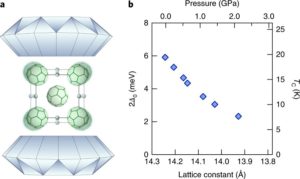
Optical excitation at terahertz frequencies has emerged as an effective means to dynamically manipulate complex materials. In the molecular solid K3C60, short mid-infrared pulses transform the high-temperature metal into a non-equilibrium state with the optical properties of a superconductor. Here we tune this effect with hydrostatic pressure and find that the superconducting-like features gradually disappear at around 0.3 GPa. Reduction with pressure underscores the similarity with the equilibrium superconducting phase of K3C60, in which a larger electronic bandwidth induced by pressure is also detrimental for pairing. Crucially, our observation excludes alternative interpretations based on a high-mobility metallic phase. The pressure dependence also suggests that transient, incipient superconductivity occurs far above the 150 K hypothesized previously, and rather extends all the way to room temperature.
Reproduced with permission. Copyright 2018, Springer Nature
